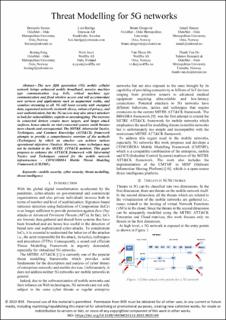Threat Modelling for 5G networks
Santos, Bernardo; Barriga, Luis; Dzogovic, Bruno; Hassan, Ismail; Feng, Boning; Jacot, Niels; Do, Thuan Van; Do, van Thanh
Conference object
Accepted version

Åpne
Permanent lenke
https://hdl.handle.net/11250/3053562Utgivelsesdato
2022Metadata
Vis full innførselSamlinger
Originalversjon
https://doi.org/10.1109/IWCMC55113.2022.9825149Sammendrag
The new fifth generation (5G) mobile cellular network brings enhanced mobile broadband, massive machine type communication (e.g. IoT), critical machine type communication and fixed wireless access and will accommodate new services and applications such as augmented reality, and seamless streaming to all. 5G will boost security with encrypted data, segmented networks (network slices), enhanced privacy, and user authentication, but the 5G success may also attract attackers to look for vulnerabilities, exploits or eavesdropping. The increase in connected devices creates more targets, and larger attack surfaces, hence attacks on vital connected systems could become more chaotic and consequential. The MITRE Adversarial Tactics, Techniques, and Common Knowledge (ATT&CK) framework attempts to provide a comprehensive overview of the methods (Techniques) by which an attacker can achieve various operational objectives (Tactics). However, some techniques may not be included in the MITRE ATT&CK matrices. This paper proposes to enhance the ATT&CK framework with Adversarial Tactics and Techniques catered for the mobile network infrastructure – CONCORDIA Mobile Threat Modeling Framework (CMTMF).